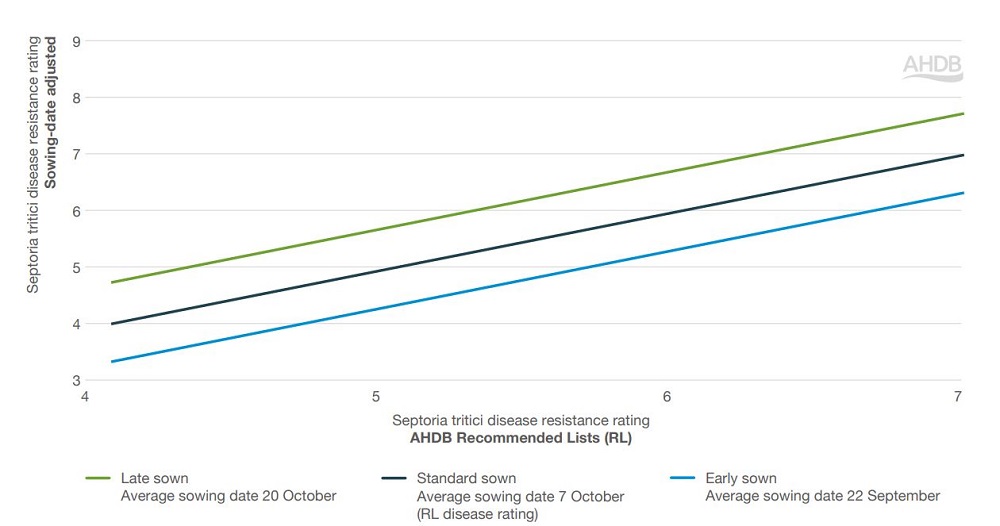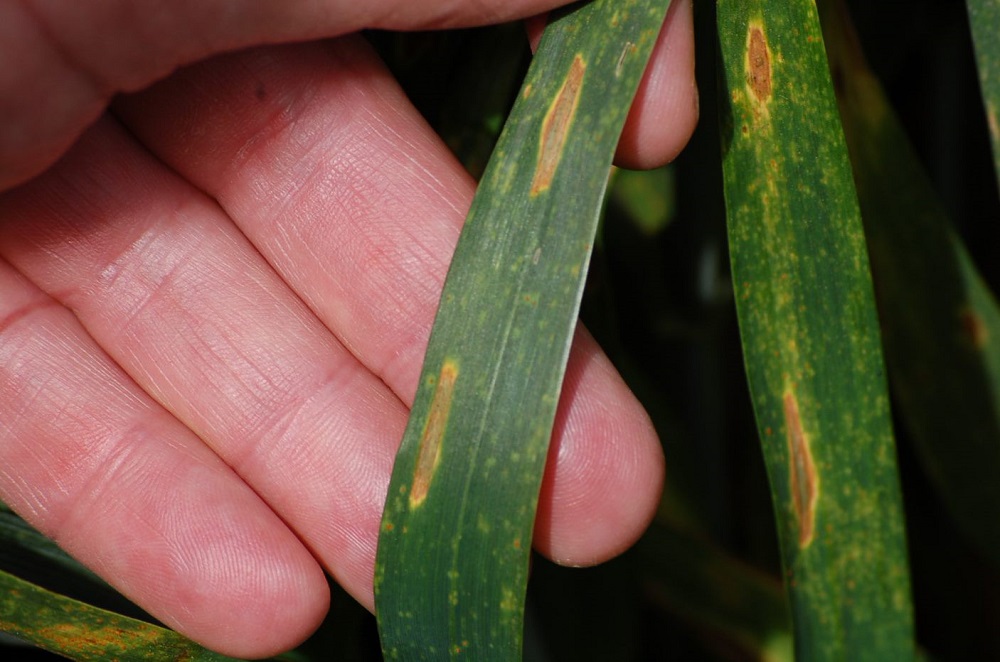- Home
- Knowledge library
- Septoria tritici in winter wheat
Septoria tritici in winter wheat
Septoria tritici is the most damaging foliar disease on UK winter wheat. The combined use of varietal resistance, cultural control and fungicides is often required for effective control in most crops.
Cereal disease management homepage
Note: Septoria tritici is commonly called septoria. It is also known as septoria leaf blotch.
What damage does septoria tritici cause in cereal crops?
Septoria tritici is the most important and damaging foliar disease on winter wheat in the UK. The pathogen reduces green leaf area for photosynthesis. It causes significant yield loss every year. It also affects grain quality. Losses of 50% may occur in severely affected crops. Unusually dry weather throughout May and June may reduce losses, but heavy dews can still allow infection. Higher rainfall areas, in the South and West, are most at risk.
Although wheat is the main host, the disease occasionally affects rye, triticale and some grass species.
Septoria tritici symptoms in cereals
Septoria often results in elongated, oval septoria lesions that are restricted by leaf veins, giving a rectangular appearance. Water-soaked patches often form, surrounded by leaf yellowing or death. Lesions may coalesce to form large areas of necrotic brown tissue. Mature lesions contain characteristic, small (but visible) black fruiting bodies (pycnidia). However, pycnidia are not always visible in immature lesions.
In most years, symptoms develop very early. On young autumn-sown wheat, symptoms may be evident by early December, and throughout the winter on the lowest leaves. During leaf production phases of growth in the winter and early spring, it is common for new leaves to appear green and healthy and for lower leaves to die back with typical symptoms. Stressed crops can show greater levels of infection.
Septoria tritici life cycle
Pathogen: Zymoseptoria tritici (teleomorph Mycosphaerella graminicola) – formerly known as Septoria tritici
Septoria survives the winter as dormant mycelium, pycnidia, and pseudothecia on crop debris, autumn sown crops and volunteers. The pathogen is not seedborne. Pseudothecia release windborne, sexually produced, ascospores. Pycnidia release asexually produced pycnidiospores. Ascospores released from previous wheat stubbles initiate epidemics in the winter and early spring. Pycnidiospores are rain-splashed from infected lower leaves. Pycnidiospores are usually responsible for the spread of the epidemic throughout the spring and summer. Physical spread of these pycnidiospores can also occur without rainfall, particularly when leaves 3 and 4 overlap the upper leaves as they emerge.
Once a spore has landed on a new leaf, it can take 12 hours for the spore to germinate. Infection of the new leaf usually takes place within 24 hours of the spore landing, providing conditions are damp. Symptoms appear after a 14–28 day latent period. The optimum temperature for Z. tritici is 15–20°C. Latent period reduces as temperatures get closer to this range.
.PNG) AHDB
AHDB
Septoria tritici: high-risk factors
- Susceptible varieties
- Early drilling
- Wet weather, especially during May and June
- Windy weather, which can increase the physical spread of spores
- Region (dry easterly regions are at less risk)
- Mild winter
Management of septoria tritici in winter wheat
Varietal resistance
Varietal resistance is key to the management of septoria tritici. A high RL septoria tritici rating can significantly reduce yield losses caused by the disease in an untreated crop and will give more flexibility in fungicide timing.
Most varieties on the AHDB Recommended List have multi-gene resistance to this disease. This means it is difficult to breed varieties with complete resistance (RL septoria tritici rating of 9), but it does mean that the resistance is durable and less likely to breakdown if the pathogen population changes (as happens with yellow rust).
However, unexpected levels of the disease were observed in 2021. This led the early release of the Recommended Lists (RL) 2022/23 septoria tritici ratings.
View septoria symptoms in winter wheat with a range of disease ratings
Septoria disease rating dip revealed by early RL dataset release (2021 news release)
Early drilled crops are exposed to incoming ascospores for longer periods and, hence, tend to have higher levels of disease throughout the winter and early spring. Although the final level of disease is determined largely by weather conditions during stem extension, delaying drilling from mid-September to mid-October can reduce final disease pressure, irrespective of the variety.
 AHDB
AHDB
Our research shows, compared with the RL ratings, on average, early sowing decreased the effective rating by approximately 0.6, whereas late sowing increased the effective rating by approximately 0.6 on the resistance-rating scale. For example, the effective rating for a variety with a RL disease resistance rating of 6 is predicted to be 5.4 and 6.6 for early-sown and late-sown crops, respectively. The disease-resistance graph is based on the range of varietal resistance ratings (4.3–7) tested in the research project.
Combining agronomy, variety and chemistry to maintain control of septoria tritici in wheat (report)
Fungicides
Fungicides are required for effective septoria tritici control in most crops. However, to reduce reliance on fungicides and the risk of fungicide resistance developing, all other cultural control methods should first be adopted to reduce the level of input required.
A typical programme for control of the disease starts at T1 to limit the disease on the lower leaves. However, the T2 timing is the most important to keep upper leaves free of disease and so optimise yield and quality. If the fungus is well into its latent phase, no fungicide will provide effective eradicant activity. There is very rarely a yield benefit associated with controlling septoria at the T0 timing, even in the highest disease pressure situations. However using septoria tritici active products at the T0 timing will reduce disease levels on the lower leaves, reducing the risk where T1 is delayed.
Prompt timing is most important on varieties susceptible to septoria tritici (rated 5 or less on the AHDB Recommended List), so these should be the priority for treatment.
Septoria tritici has a high propensity to develop resistance to fungicide modes of action. Resistance to strobilurin products is widespread and they do not provide adequate control. Although resistance to azoles and SDHIs is also widespread in UK septoria populations, they still provide good levels of control, although azoles need to be applied at or close to full label rate to reach acceptable efficacy levels. As new modes of action and newer, more active, members of currently available modes of action are introduced, they should result in improved levels of septoria control, but will need to be protected from the development of resistance.
Fungicide programmes for wheat
Summary
- Grow a variety with a high septoria tritici resistance rating
- Avoid early drilling, especially of susceptible varieties
- The T2 fungicide timing is the most crucial, with T1 also targeted at septoria tritici control. However, the T0 spray rarely gives a yield benefit
- Use a balanced mixture of an azole with a multisite (where possible). Only add an SDHI when disease risk merits it
- Use the lowest dose possible to get the required control, but ensure that each component of the mix gives comparable levels of control
 AHDB
AHDB
Disease-risk map for septoria tritici
.PNG) AHDB
AHDB
| High | Moderate | Low |
Disease assessments
With a focus on yellow rust and septoria tritici in wheat, this video shows how disease severity is assessed in RL trials using a standardised scale (0 to 100 per cent)
Webinar
Septoria tritici management in winter wheat was the topic at the Saltash Monitor Farm (Cornwall) webinar in January 2023. This recording details AHDB fungicide performance results and resistance monitoring data. The webinar also presented integrated control solutions, including the use of varietal mixtures. Finally, the webinar featured a perspective on septoria control in Ireland, where the erosion of disease resistance, associated with varieties that feature Cougar in their parentages, is a particular issue.
 AHDB
AHDB
Cereal disease management
Visit our main page for disease management in this crop

Recommended Lists
Information on yield and quality performance, agronomic features and market options to assist with variety selection
.png) AHDB
AHDB
Published control curves are based on septoria data (black solid lines). However, the faster-cycling rusts, with their shorter latent period, result in tighter curves (yellow dotted lines).

